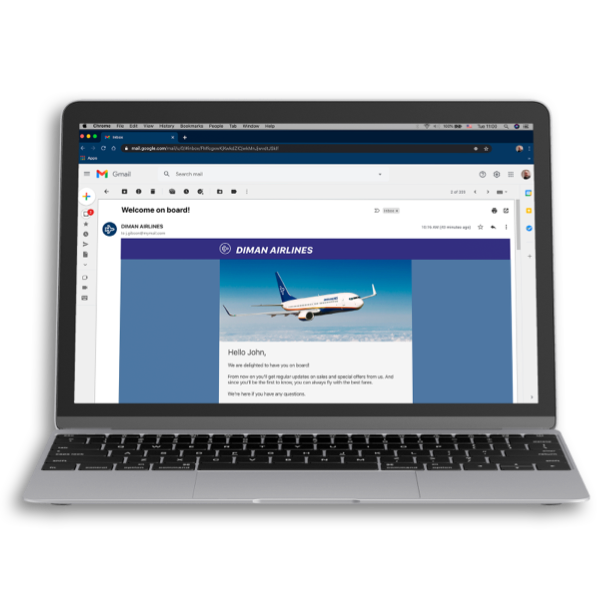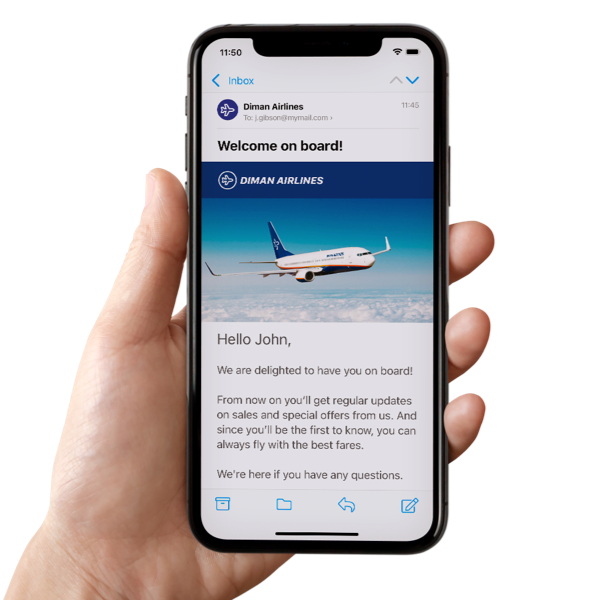
How to write the perfect welcome email for new users and subscribers
Consumers find your business attractive and they are certainly into you. Now it is time to wow your new subscribers with your welcome email and make a good first impression. According to research, 74.4% of users expect a welcome email when signing up or subscribing to a website or newsletter.
A welcome email is the first interaction you have with your new subscribers after they have confirmed their interest in you. The main goal of this first email message is to confirm a new registration and welcome a new subscriber aboard but to also create a welcoming and warm environment for newcomers to feel like they have made the right choice in subscribing to your content.
Why is the welcome email important?
Welcome emails have an average open rate of 52.09%, which is 86% higher than other emails . Besides, new subscribers tend to read those emails and even buy when incentivized by them, reporting an average conversion rate of about 3%, which overcomes the majority of other automated emails sent by eCommerce businesses.
A welcome email conceals many opportunities to approach your new subscribers and build relationships with them. On top of that, this type of email builds up a powerful lead generation engagement. However, if you fail to communicate effectively with newcomers, soon they can turn to your competitors. To help you in making the best first impression possible, we have assembled some tips on how you can make your welcome email stand out.
How to make your welcome email attract attention
1. Show appreciation
“Thanks” is one of the most powerful words to use in your emails, as it adds a human quality to your email and also builds brand loyalty. Show your appreciation to new subscribers for joining your email list, with a short written note, or with the use of images, videos, or GIFs, keeping in mind your brand’s tone of voice of course.
When subscribers know you appreciate them, they are more likely to have positive feelings towards you and your brand.
Communicate in a friendly way with your new subscribers using personalization, so you can help them relate to your brand and enhance their sense of belonging to a group. Including a subscriber’s first name may catch their attention and increase engagement.
2. Be straightforward
Explicitly tell your subscribers what they can expect from you. Your welcome email should be the place where you set expectations.
Share information about the type of content (sales, offers, new blog posts, product releases, company news, and so on) and set the frequency of how often your subscribers will receive emails from you (monthly, weekly, daily, etc.) is essential.
Being as clear as possible helps build trust with your new audience, defines the relationship, and prevents subscribers from being unpleasantly surprised by your email content – leading to spam complaints and unsubscribes. It can also increase the excitement for what you will be offering them and the value you will be providing them.

3. Tell your story
Storytelling is a smart marketing method to show your brand’s personality and start building meaningful connections with your audience. Your welcome email is a great place to share who you are, what you do, and how you can help your customers. It allows you to connect with subscribers on a more profound level and sets you apart from the competition. Keep in mind that not everyone who signs up for your list is already a converted customer. They might need a little extra information about you and your brand to build up trust.
Play your strong cards: beautiful images of happy customers, your most popular products, free returns warranty, and so on. The more subscribers familiarize themselves with who you are and what you do, the better chances you have to sell your product or service in later emails.
4. Build customer care communication bridges
Share with your new subscribers your customer service contact information to make yourself accessible to them. Provide them with ways to further your relationship and learn more about them by giving them the chance to reply to your emails or call you.
Remember to provide them with the links to your social proof by giving them your official social media profiles on Facebook, Twitter, Instagram, etc., and encourage them to follow your pages and connect with your brand. If they like receiving your emails, they will most likely enjoy your social media updates too.
5. Ask to get whitelisted
The first email is the best time to ask your subscribers to whitelist your email address, that is to add you to their contact list, so your future emails make it to their Primary inbox, instead of their Spam folder. It is very likely that subscribers are waiting for your email and will open it as soon as it hits their inbox. Your welcome email is an ideal message to ask subscribers to whitelist your email address, compared to asking them weeks or months later. Offer instructions on how they can whitelist your email address and emphasize the benefits of doing so (special deals, valuable updates, and so on).
6. Place a clear call-to-action (CTA)
Boost email conversion rate by designing and placing an effective call-to-action (CTA) button in your welcome email message. Depending on your goals, you may encourage your customers to complete a series of different actions. For example, you may ask them to visit your website to learn more about your company or products, to read an article on your blog, to provide you with feedback, to enter a giveaway contest for new subscribers, to get a special discount for their first purchase, and so on. Make sure your call to action is clear, stylish, catchy, and simple to act upon for the customer.
When designing a CTA button, remember that every small detail matters. The size and color of the button as well as the font’s size, color, and type may influence the effectiveness of your email marketing campaign. By running an A/B test of your CTA, you can measure the effectiveness of different variants.

7. Keep your message short
No one enjoys reading long emails. So if you want customers to read the entire email, you should keep it short. Instead of writing just text, try to enrich your welcome message with some media content, so you can grab attention and build a strong visual brand identity. It is important to keep your email templates visually appealing to increase your chances of capturing the attention of your new subscribers who most probably receive a bunch of emails every day.
8. Create a welcome series
If a welcome email can prove beneficial, imagine what a sequence or series of welcome emails can do! An email sequence of welcome emails is an ideal way to onboard your new subscribers. Research shows that a sequence of three welcome emails can generate 90% more orders than a single welcome email. By onboarding your new subscribers with more than just one email, you can add more information about your brand, creating and reinforcing a solid first impression that can ultimately boost your sales.
A welcome email series can take many forms. For example, you can send an email when a user subscribes to your email thanking them for subscribing, followed by a second email a couple of days later, offering a special coupon for their first purchase, and a third email a few days after with instructions on how to find you on social media or register for your loyalty program.
What’s next for your business?
Your welcome emails are like brand ambassadors for your business. They have the ability to make or break your brand. It is essential that they create a warm and welcoming environment for your subscribers and that they include elements of your brand identity, embodying its personality. Welcome emails can enable you to grow your brand, building strong and loyal relationships.
Regardless of whether you decide to send one single welcome email or a series of three to five welcome emails, you can always automate the onboarding process with the right marketing automation platform. With Waymore you can easily create automated welcome email workflows, perfectly fit your needs.
